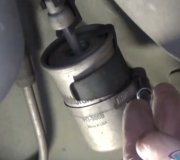Hold on a second, hamburger thawing in microwave. Be right back.
Okay, I am back.
I am no typist so bare with me.
Couple years ago, dune buggy and hot VW magazine wrote a tech article with pictures on how to go about replacing the fuel line.
The fuel line is metal from the rear, through the horn arm and into the tunnel. Comes out under the fuel tank. Metal all the way.
Water and dirt, enemies of that metal line. Rust forms dirt collects on the rust. More rust, eventually the line plugs.
You might try blowing compressed air through the original line or running a long piece of braided cable, like a speedometer cable with a lead slug or brass tip of some sort to guide the cable around the turns and bends in the line. Provided the original metal fuel line is not rusted through and the air or the cable pushes through, you may be able to use the original fuel line, with maybe a couple fuel filters in series.
The metal fuel line is attached at several different locations inside the tunnel. It will not pull nor push out.
The only way to replace it is to cut openings into the tunnel, cut loose the attachment points and pull in a new metal line using the original as a pull.
Unfortunately with out a factory road map, we do not know where the line is attached to the tunnel.
The article in hot VW showed how to cut open the tunnel, where the attachments are, how to remove the attachments. How to replace the fuel line. Where to reattach to the inside of the tunnel. Then how to seal the holes in the tunnel.
Think they said it took an expert over sixteen hours to do this job. It was suggested that, with this article as a guide a skilled craftsman at home could do this in their garage. That is as long as paid close attention to the article and followed every direction.
My local shop gets $100.00 an hour without batting an eye and customers pay it. So, sixteen hours at $100.00 an hour equals $1,600.00.
I need to do the same on my manx dune buggy. The metal line needs to be attached inside the tunnel or it will rub and get cut through. If you do not replace and just add another metal line, cut access holes in the tunnel, drill a hole in the horn or in the rear of the pan ahead of the front transmission mount.
You can then pass another metal line through the tunnel to the front. You will need to drill a hole in the tunnel under the gas tank for the line to come through.
Best to carefully drain the fuel out of the tank ( disconnect the battery, both cables before you attempt to remove the gas tank ) and remove it to access the area under the fuel tank.
It will be a pain to run the new line through the tunnel, pushing it along, a friend at the access points guiding it.
No magic, no easy way to do this. It will be difficult and you need to be extremely careful.
If you attempt it, find that article in hot VW.
I do not know exactly how long ago they wrote it. They replaced the line with a larger one for a larger displacement engine they were running.
Good luck, and remember take your time and always think safety first.
SPONSORED LINKS
Saturday, June 28th, 2008 AT 11:13 PM



